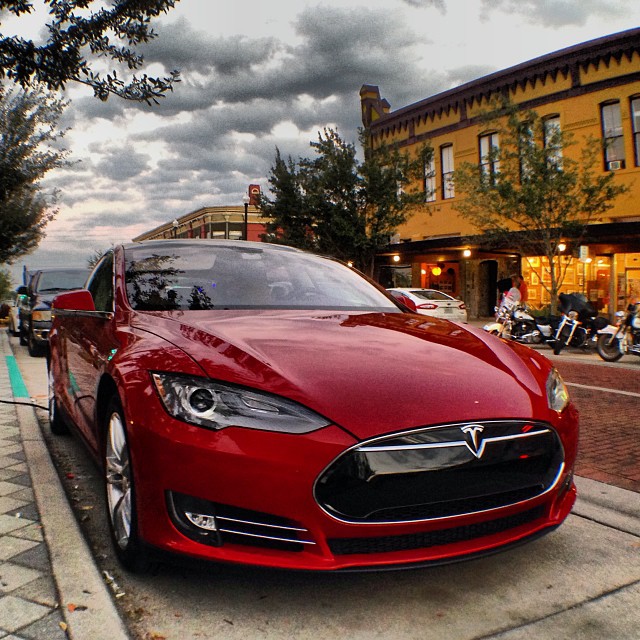It’s one facet of the American myth: Get in your car, drive away from wherever you are, take the road trip.
Think crossing the country to find the Californa Dream. Think Jack Kerouac’s On the Road. Think buddy movies.
MORE: Tesla Model S Road Trip: 1,200 West Coast Electric-Car Miles
More prosaically, think about driving 600 miles to visit friends or relatives, because flying would mean a connecting flight and TSA security theater–and there are no trains.
Battery electric cars make those kinds of road trips impossible, the spontaneity 10-minute refueling enabling hundreds, thousands of miles at a stretch.
Or do they?
We published a pair of Tesla road-trip reports this week, each totaling about 1,200 miles, one from the West Coast (the home of Tesla Motors), one from the East Coast.
Both were made possible by Tesla Motors’ ambitious plans to install a nationwide network of Supercharger DC quick-charging stations that work so far only with its Model S electric luxury sedan.
Both of our authors relied on Supercharger stations to give them free recharges of up to 80 percent capacity in 20 to 30 minutes. It’s a benefit unique to owning a Tesla Model S, as long as buyers equip their cars with Supercharger capability.
MORE: Life With Tesla Model S East-Coast Road Trip: Freeze In Slow Lane, Or Languish At Nissan Dealers?
But the book-end road-trip reports highlight some lessons for now and future Tesla owners considering their own road trips.
(1) It’s Superchargers or nothing; Level 2 charging isn’t adequate.
To fill in the gaps between Superchargers located just a bit too far apart for a comfortable cold-weather margin in his 60-kilowatt-hour Model S, East Coast road-tripper David Noland relied on the kindness of Nissan dealers, who let him use their 240-Volt Level 2 charging stations.
Compared to Superchargers, with those half-hour-or-less 80-percent recharges, a Level 2 station is pitifully slow at adding range to a Tesla and its large battery pack.
Noland was surprised to find that it took 40 minutes to add 12 miles of range at a Nissan dealership in Ramsey, New Jersey. Contrast that to the latest 120-kilowatt Superchargers in Glen Allen, Virginia, which added 6 miles each minute.
(2) Speed, temperature, hills, and headwinds all matter, a lot.
Temperate West Coast weather meant that George Parrott had to use his cabin heater less than David Noland on the East Coast. Heating is really the Achille’s Heel of today’s battery-electric cars, using lots of energy to warm a fairly large cabin through resistance heaters.
But each driver found that additional speed chewed up energy, as did the hills and headwinds Parrott had to contend with.
Moral: To stretch your trip, drive at 60 or 65 mph rather than 75 mph (where it’s safe and practical), and pack a parka if it’s cold.
The hills and headwinds you just have to accommodate.
(3) At a Supercharger location, amenities count.
Before the Supercharger locations actually began to appear, owners and advocates expected them to be located at luxury hotels and other distinctive venues that would supposedly appeal to Model S owners.
In reality, they’re located on or near Interstate rest stops, along the edges of parking lots, and convenient to the way Americans usually route their road trips: along highways.
The first requirement nearby is a bathroom accessible to the public, followed by a diner, restaurant, or other venue for refreshments and a place to sit down.
Most Superchargers offer most of these, but it can be a challenge: West Coast road-tripper George Parrott notes that to reach the Woodburn Outlet Mall–where the Woodburn, Oregon, Supercharger is supposedly located–requires hiking a third of a mile through, among other things, the service area of a car dealership.
Considerably closer to those Superchargers are an Arby’s, an Elmer’s Restaurant, and a Starbucks, however, so the basics are covered. But for any road-trippers who might plan on a couple of hours of outlet shopping as a bonus, the challenge was greater than expected.
(4) The 85-kWh Model S is a much better road-trip car than the 60-kWh model.
This was Noland’s painful discovery.
In the winter, where heating has to be used, the East Coast Superchargers are spaced far enough apart that he would have had a comfortable margin in an 85-kWh Model S.
But his car has the smaller 60-kWh battery pack, and the margins were just too close–hence his need to top up at the Nissan dealers’ slow Level 2 charging stations.
Thinking about road-tripping in your Tesla? Buy the big battery. Period.
Today’s Supercharger spacing does make us wonder, however, how practical they’ll be if Tesla is able to introduce its less expensive next model, in 2017, which is expected to offer about 200 miles of range.
(5) Even electric-car owners want to take road trips occasionally.
This lesson runs counter to the line espoused by many electric-car advocates: People can learn to live within the limits of electric-car range, which even at 75 miles covers the vast majority of everyday use.
That’s largely true, but if you have a big, stylish, comfortable electric luxury car like the Tesla Model S, it’s a natural to want to use that car as much as possible–including for the occasional longer trip.
Why? Because electric cars are just nicer to drive than their gasoline or diesel counterparts.
What other lessons did you take away from the two Tesla road-trip reports?
Leave us your thoughts in the comments below.
This story originally appeared on Green Car Reports. Copyright 2013


